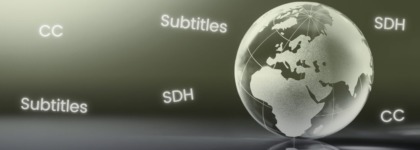How to Elevate Your Broadcast’s Live Captioning Quality
Updated: December 14, 2022
FCC Requirements for Closed Captioning of Online Video: Are You Compliant? [Free White Paper]
Television is a 24/7 industry. Networks are always broadcasting something, and much of what they’re airing is happening live, in real time. Live captioning is a critical component of these live broadcasts, but can sometimes be a source of frustration for viewers due to style inconsistencies, latency issues, and inaccuracies in transcription. Many have simply accepted that this is just the nature of live captioning. But we’ll let you in on a secret: there are some easy ways to elevate your live captioning quality from acceptable to all-star. We’ll show you how in this blog.
Set Your Live Captioner Up for Success with Prep Materials
One of the easiest and most effective ways to improve your live captioning quality is to provide prep materials to your live captioning vendor ahead of the broadcast. The pacing of live broadcasts means that live captioners must make split-second judgment calls and are ultimately driven to get audio transcribed as quickly as possible in a live environment. While live captioners can correct a word if they mistranscribe, that can be hard to do when there’s no context or materials available ahead of time. That’s where prep materials come in.
When productions provide helpful information such as proper name spellings, key terms, and wordlists, live captioners are able to reference and contextualize this information during the captioning process by creating dictionaries and glossaries of key terminology and names to have on hand as they caption. This ensures more accurate spellings and transcription of your broadcast content, automatically improving your live captioning quality.
So how do these dictionaries/glossaries work? Powerful software used by live captioners (who may be using either a stenography machine or voice writing methods to transcribe closed captions) allows them to maintain active control over the accuracy and formatting of the words they’re creating.
For instance, say a captioner is scheduled to caption a live baseball game. They’re going to create a robust glossary of baseball vocabulary, ranging from the basic—bat, base, outfield—to the specific—dinger, WHIP, fungo. This dictionary will also include a list of personnel involved with the game: rosters of both teams, the broadcasting crew, umpires, and information about the stadium and city it’s located in.
A Strong Network Connection = Strong Live Captions
In live programming, issues with antennas and cable can corrupt data streams and the transmission of captions. 608 and 708 closed captioning data is decoded to make captions appear overlayed on a video stream. These are typically stable when being transmitted through a strong network connection, giving you live captions that appear as intended by the captioner.
However, poor weather, weak transmission signals, internet quality, and satellite issues can all affect these captioning streams. This can result in missing words, strange characters, caption placement changes, or even change the color of the captions.
Some of these factors, like the weather, can’t be helped. But some, like poor internet quality, can be improved. Aim to use the most stable and high quality connection as possible when working with your live captioning vendor and test with them pre-broadcast.
While testing, a live captioner should use their captioning software to connect to the client’s encoder or virtual captioning session and send test captions. At this point, they should also confirm with you that captions are being properly received and that what they are hearing is correct, be it the sound of the preceding program, tone, or silence. This testing is designed to provide a clean, constant link between the captioner and broadcaster, allowing them to caption with as low latency as possible.
In the cases where a live stream drops anyway, 3Play offers Stream Reconnect Wait Time to give you peace of mind that your captioning service will pick back up without unnecessary delay.
The Clearer the Speech, the Clearer the Captions
Most producers and captioners of live broadcasts know that audio quality can be a mixed bag. But if you’re looking to make accessibility part of the live broadcasting process from the start and get the highest quality, compliant live captions, consider implementing a few of these tips to get clearer audio during your live broadcasts. (Note that not all audio tips are going to be possible for every broadcast due to the nature of different live events, such as sporting games.)
Aim for High Quality Audio
Whenever on-air talent is speaking, they should be using a high-quality microphone. Ensure speakers are enunciating and speaking as steadily as possible into the mic line to get clear speech. If no direct mic line is present, make it a best practice to have speakers repeat important information and questions in case captioners or viewers don’t hear it the first time.
Avoid Unnecessary Background Noise
Loud cheering, applause, and overlapping chatter is unavoidable in some programs, but when possible, avoid on-air talent and speakers having to compete with loud background noise by dampening sound inside studio settings.
One Speaker at a Time
Overlapping chatter is a top reason why captions may be transcribed incorrectly. When possible, ask on-air talent and speakers to speak one at a time and avoid talking over one another.
What does the FCC say about the captioning of live and online video? ➡️Highly Trained Live Professional Captioners are Key
Using highly trained live professional captioners is essential for live broadcasts. Live automatic captions on their own will not be sufficient for television and OTT streaming, so it’s imperative to ensure humans are part of your live captioning process. But even if you have a live captioner doing the work, how do you know if they’re the right fit for your broadcast?
When vetting a live captioning vendor, check if their live captioners are professionally trained in proven methods like stenography or voice writing. 3Play Media live professional captioners consist of a team of in-house staff and contractors with robust training and qualifications that enables you to get your broadcast programming live captioned at a high level of quality without hassle.
Where does ASR fit into this? ASR and auto captioning solutions aren’t usually recommended for broadcast television and high-visibility events on their own, but they can serve as a helpful reference for a live captioner who is editing ASR as they go, a backup option when a connection drops, or a way to make content accessible when professional captioners are not an option. If you have a resilient failover captioning solution, ASR can ensure captions keep going and your broadcast remains accessible while you and your captioning vendor troubleshoot any drop issues.
Be Mindful of FCC Guidelines
While no governing body or official rules exist to regulate live captioning at this time, Federal Communications Commission (FCC) regulations and other legal precedents still compel live broadcast programming to be captioned at a high accuracy rate.
The FCC lists best practices for live captioning of televised video for both vendors and captioners, and while they do allow for some leniency in quality compared to recorded captioning quality, they suggest live captioners aim to “caption as accurately, synchronously, completely, and appropriately placed as possible, given the nature of the programming.”
3Play’s live professional captioning accuracy rates typically range between 95% to 98% or higher for live broadcasts, with a focus on comprehensibility. We also provide future-proof paths to upgrading live captions and transcripts to 99% accuracy and FCC compliance for recorded broadcasts or re-air of programming after your live broadcast has ended.
Elevating Your Live Captions
Some of the tips listed above aren’t always going to be possible due to the nature of broadcast television and the fast-paced, ever-evolving media and entertainment industry. But they’re good starting points for producers and networks who strive to build inclusivity and accessibility into the production process from the start.
It may initially require a little extra effort, but when you set high standards for the live captioning of your broadcast programming, you’re creating a better, more inclusive experience for all of your viewers.






